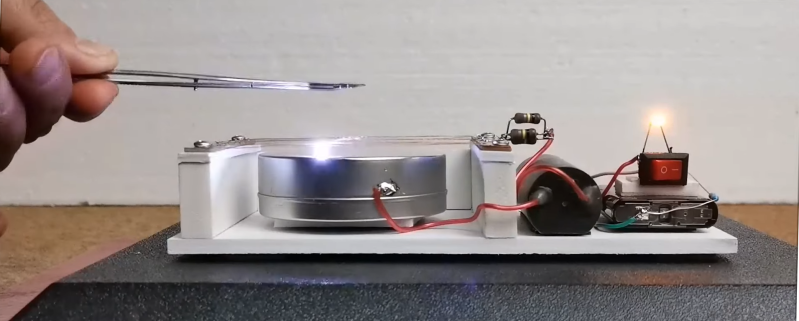If you want to measure radioactivity, nothing really beats a Geiger counter: compact, rugged, and reasonably easy to use, they’re by far the most commonly used tool to detect ionizing radiation. However, several other methods have been used in the past, and while they may not be very practical today, recreating them can make for an interesting experiment.
[Mirko Pavleski] used easily obtainable components to build one such device known as an alpha radiation spark detector. Invented in 1945, a spark detector contains a strong electric field into which discharges are triggered by ionizing radiation. Unlike a Geiger-Müller tube, it uses regular air, which makes it sensitive only to alpha radiation; beta and gamma rays don’t cause enough ionization at ambient pressure. Fortunately, alpha radiation is the main type emitted by the americium tablets found in old smoke detectors, so a usable source shouldn’t be too hard to find.
The construction of this device is very simple: a few thin copper wires are suspended above a round metal can, while a cheap high-voltage source provides a strong electric field between them. Sparks fly from the wires to the can when an alpha source is brought nearby; a series resistor limits the current to ensure the wires don’t overheat and melt.
Although not really practical as a measurement device, the spark detector can nevertheless be used to perform simple experiments with radioactivity. As an example, [Mirko] demonstrates in the video embedded below that alpha particles are stopped by a piece of paper and therefore present no immediate danger to humans. The high voltage present in the device does however, so care must be taken with the detector more than with the radiation source.
We’ve seen several homebrew Geiger counters, some built with plenty of duct tape or with the good old 555 timer. But you can also use photodiodes or even certain types of plastic to visualize ionizing radiation.
















To say that beta and gamma radiation doesn’t cause enough ionization at ambiend pressures strikes me as wrong. It’s just that an alpha particle is several thousand times more massive, giving it a much greater chance of striking other matter.
Alpha particles deposit much greater energy (and ionization) per unit length — enough to leave an ion trail dense enough for the imposed electric field to literally ‘connect the dots’ and cause the avalanche discharge (spark).
Photons (X, gammas) or electrons (betas) don’t deposit nearly that amount of energy per unit length, so are essentially undetectable by this kind of device.
Interesting article. A bit to many commas, but the article can still be parsed if the reader pays attention. There is one bit of odd wording though: “The high voltage present in the device does however, so care must be taken with the detector more than with the radiation source.” The “more than with” seems to have been misplaced. This sentence would have flowed much better if it had been “The presence of the high voltage in the device does make the detector more dangerous than the radiation source.”
‘too many commas.’ Can we get an edit button already?
‘too many commas,’ Can we get an edit button already?
EDIT…
Santa!!!!!! Why did you forget that button again?
It’s that the ‘more’ modifies ‘care’, but turns up about a mile down the road. Relocate it thusly, and voila! “The high voltage present in the device does however, so more care must be taken with the detector than with the radiation source.”
I asked yoda and it is fine :)
“present no immediate danger to humans”
unless it is in your lungs – then it is the MOST harmful
Or ingest it any other way. Alpha sources deposit all their energy in a very small volume, which, if it is inside you, can cause considerable harm to nearby cells. Polonium-210, used by the Russians for assassination, is an alpha emitter. It was delivered to Alexander Litvinenko in the form of tea.
Another solution. (My grandson did this when he was 8)
http://www.youtube.com/watch?v=xky3f1aSkB8
Great project. Alpha is blocked my almost everything, having something easy to make that can visualise it would be much fun. None of my kit can measure low energy alpha. Just gamma and some beta. Which gives erroneously low measurements for thoriated glass.
Made an ionisation chamber for detecting high gamma flux once. If you’d held the source over it with your hand, you’d have soon run out of hands. Dose rate was about 1 kSv/h. A bit high.
,,,,,,,,,,,,,,,,,,,,,,,,,,,,,,,,,,,,,,,,,,,,,,,,,,,,,,,,,,,,,,,,,,,,,,,,,,,,,,,,,,,,,,,,,,,,,,,,,,,,,,,,,,,,,,,,,,,,,,,,,,,,,,,,,,,,,,,,,,,,,,,,,,,,,,,,,,,,,,,,,,,,,,,,,,,,,,,,,,,,,,,,,,,,,,,,,,,
Isn’t this how most radon monitors work? I could swear the 90s-era Continuous Radon Monitor machines my dad used in home inspections were this exact construction, inside a shielded box with screen windows for air exchange.
Applied Science, youtube, Apr. 5, 2020, “Alpha radiation makes sparks, detects smoke, and eliminates static cling”
https://www.youtube.com/watch?v=ZBHIp967TD8